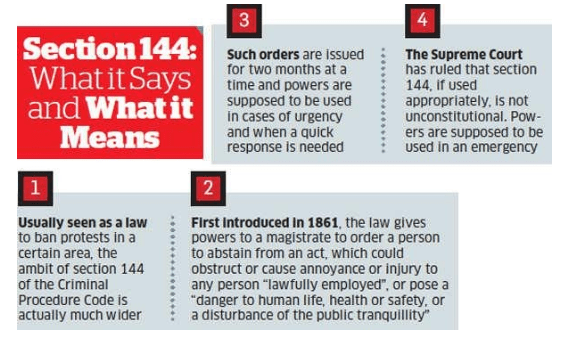UPSC Articles
POLITY
TOPIC: General Studies 2:
- Important aspects of governance, transparency and accountability, e governance- applications, models, successes, limitations, and potential; citizens charters, transparency & accountability and institutional and other measures.
- Role of civil services in a democracy.
Section 144: Protests against Citizenship Amendment Act & Section 144

Daily Current Affairs IAS | UPSC Prelims and Mains Exam – 20th December 2019
Context:
- As protesters against the Citizenship Amendment Act hit the streets in large numbers in several states , state governments sought to tamp down on the demonstrations by issuing prohibitory orders under Section 144 of the Code Of Criminal Procedure (CrPC), 1973.
Section 144 CrPC:
- Section 144 CrPC, a law retained from the colonial era,.
- It empowers a district magistrate, a sub-divisional magistrate or any other executive magistrate specially empowered by the state government in this behalf to issue orders to prevent and address urgent cases of apprehended danger or nuisance.
- The magistrate has to pass a written directed against a particular individual, or to persons residing in a particular place or area, or to the public generally .
- In emergency cases, the magistrate can pass these orders without prior notice to the individual against whom the order is directed.
Powers under Section 144 CrPC
- The magistrate can direct any person to abstain from a certain act or to take a certain order with respect to certain property in his possession or under his management.
- This usually includes restrictions on movement, carrying arms and from assembling unlawfully. It is generally believed that assembly of three or more people is prohibited under Section 144.
- It can be used to restrict even a single individual.
- Order passed under Section 144 can remain in force for more than two months from the date of the order
Criticisms:
- It is too broad and the words of the section are wide enough to give absolute power to a magistrate that may be exercised unjustifiably.
- An aggrieved individual can approach the High Court by filing a writ petition if his fundamental rights are at stake. However, fears exist that before the High Court intervenes, the rights could already have been infringed
- Imposition of Section 144 to an entire state has also drawn criticism since the security situation differs from area to area.
SC Judgements:
1961 in Babulal Parate vs State of Maharashtra and Others
- The Supreme Court refused to strike down the law, saying it is “not correct to say that the remedy of a person aggrieved by an order under the section was illusory”.
1970 (Madhu Limaye vs Sub-Divisional Magistrate):
- a seven-judge Bench the power of a magistrate under Section 144 “is not an ordinary power flowing from administration but a power used in a judicial manner and which can stand further judicial scrutiny”.
- It ruled that the restrictions imposed through Section 144 cannot be held to be violative of the right to freedom of speech and expression, which is a fundamental right because it falls under the “reasonable restrictions” under Article 19(2) of the Constitution. The fact that the “law may be abused” is no reason to strike it down
Conclusion:
- Section 144 is a useful tool to help deal with emergencies. However, absence of any narrow tailoring of wide executive powers with specific objectives, coupled with very limited judicial oversight over the executive branch, makes it ripe for abuse and misuse.
Connecting the dots:
- Do you think Section 144 is being misused?
- Do you think Section 144 curbs Fundamental rights?













